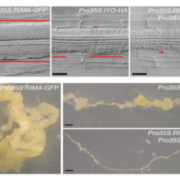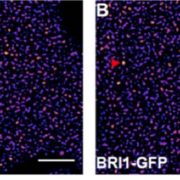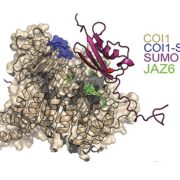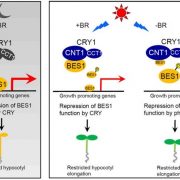Photoperiodic control of seasonal growth is mediated by ABA acting on cell-cell communication ($) (Science)
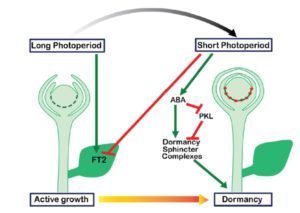 Plant growth is regulated seasonally, but our knowledge is limited about how their growth is inhibited or re-initiated seasonally. Looking at hybrid aspen, in this article, Tylewicz et al. explored how seasonal cycles of growth and dormancy help perennial plants adapt during winter. In the long days of summer, FT1 (FLOWERING LOCUS T 1) is expressed and moves between cells to the shoot meristem and promotes growth. In winter, short photoperiods suppress FT1 expression. Furthermore, there is an increase in the level of ABA and its response. Due to the change in ABA response, callosic dormancy sphincters form, which cause plasmodesmata to close, interfering with cell-to-cell communication and FT1 transfer to the meristem. Interestingly, overexpression of PDLP1 (PLASMODESMATA-LOCATED PROTEIN 1) is sufficient to block the release of bud dormancy after transfer to long photoperiods, without changing the ABA response. Taken together, the model suggests that shorter photoperiods alter ABA response and plasmodesmata closure, which prevents precocious growth during the period of dormancy. (Summary by Arif Ashraf) Science: 10.1126/science.aan8576
Plant growth is regulated seasonally, but our knowledge is limited about how their growth is inhibited or re-initiated seasonally. Looking at hybrid aspen, in this article, Tylewicz et al. explored how seasonal cycles of growth and dormancy help perennial plants adapt during winter. In the long days of summer, FT1 (FLOWERING LOCUS T 1) is expressed and moves between cells to the shoot meristem and promotes growth. In winter, short photoperiods suppress FT1 expression. Furthermore, there is an increase in the level of ABA and its response. Due to the change in ABA response, callosic dormancy sphincters form, which cause plasmodesmata to close, interfering with cell-to-cell communication and FT1 transfer to the meristem. Interestingly, overexpression of PDLP1 (PLASMODESMATA-LOCATED PROTEIN 1) is sufficient to block the release of bud dormancy after transfer to long photoperiods, without changing the ABA response. Taken together, the model suggests that shorter photoperiods alter ABA response and plasmodesmata closure, which prevents precocious growth during the period of dormancy. (Summary by Arif Ashraf) Science: 10.1126/science.aan8576



